
A PILGRIMAGE STORY OF DOLPO
The Sacred "Crystal Mountain"
of Dolpo and Druptop Senge Yeshi
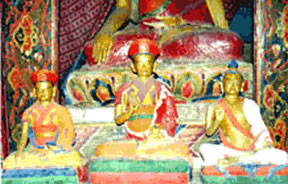 Dolpo
Shel-Re Drugdra is the Tibetan name of the sacred mountain.
It literally means "Dolpo Crystal Mountain of the Dragon's
Roar". The Crystal Mountain is situated in Dolpo, in north-east
Nepal. Dolpo
Shel-Re Drugdra is the Tibetan name of the sacred mountain.
It literally means "Dolpo Crystal Mountain of the Dragon's
Roar". The Crystal Mountain is situated in Dolpo, in north-east
Nepal.
In the 12th century, a Dharma
practitioner, Druptop (a "mahasiddha" or highly-realized
being) Senge Yeshi, was sent to Dolpo by his master, Lord Jigten
Sumgon, founder of the Drikung Kagyu Order of Tibetan Buddhism.
On his arrival there, he saw Dechog (Chakrasamvara) at the Crystal
Mountain and he heard the sound of a dragon roaring. Having directly
perceived the holiness of the mountain, Senge Yeshi christened it
"Shel-Re Drugda" and riding on a lion, he consecrated
the sacred land.
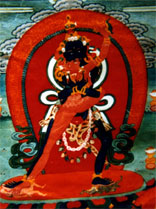 Dechog
is a wrathful Tantric deity, whose image is usually depicted as
locked in sexual congress with his
consort, Dorjee Phagmo. Together, the pair symbolize the union of
the great compassion and the wisdom, which are an essential combination
for achieving enlightenment. The practices associated with Dechog
are widely practiced by all the Tantric traditions of Tibetan Buddhism. Dechog
is a wrathful Tantric deity, whose image is usually depicted as
locked in sexual congress with his
consort, Dorjee Phagmo. Together, the pair symbolize the union of
the great compassion and the wisdom, which are an essential combination
for achieving enlightenment. The practices associated with Dechog
are widely practiced by all the Tantric traditions of Tibetan Buddhism.
 In
1995, Senge Tenzin Rinpoche was recognized as the reincarnation
of the great saint, Senge Yeshi (the Limi Tulku), by His Holiness
the Drikung Kyabgon Chetsang Rinpoche, the head of Drikung Kagyu
Order. In
1995, Senge Tenzin Rinpoche was recognized as the reincarnation
of the great saint, Senge Yeshi (the Limi Tulku), by His Holiness
the Drikung Kyabgon Chetsang Rinpoche, the head of Drikung Kagyu
Order.
In 2000, Senge Tenzin Rinpoche
went on the pilgrimage to the sacred Crystal Mountain. According
to the Tibetan lunar calendar, it was "Dragon Year" and
the festival of Shel-Re Drugda, which comes every twelve years.
The year is believed to earn multiple merits. Senge Rinpoche decided
to go there at that auspicious time just after he had completed
his three years' retreat. By the time, he hadn't cut off his retreat
hairs. His goal was to say his prayers and to gain access to the
blessing and knowledge of the great practitioner, Druptop Senge
Yeshi, who had lived and practiced there for many years. Also, Senge
Tenzin Rinpoche liked to meet the regional people of Dolpo. The
pilgrimage was supported and funded by His Holiness the Drikung
Chetsang Rinpoche.
Journey from the Drikung Kagyu
Institute, India, to Dolpo
Senge Tenzin Rinpoche,
accompanied by ten monks including Kyenpo Tashi Kailash, Ven Jovo,Ven
Konchok Kunsang, started on a journey from the Drikung Kagyu Institute
in Dehra Dun, in the east of India.
Nepalgunj Airport -
There are only two ways to get to Dolpo - either by plane or on
foot. The group decided to fly because they had too much luggage
to carry for walking to be feasible and it would also have been
too difficult to cross the mountains on the way to Dolpo. Although
air transport was a big problem for the thousands of Buddhist pilgrims,
tourists and local travelers, the group managed to get a flight
with the National Royal Nepal Airline from Nepalganj to Zuphel,
the closest airport to Dolpo. Their airplane could only carry eighteen
people, each person with fifteen kilograms of luggage.Then there
was five days journey on foot to get to the sacred Crystal Mountain.
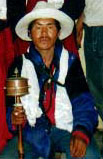 At
Zuphel, we met Mr Pema carrying a prayer wheel in his right
hand and a Mala, or rosary, in his left hand. He was the first local
Dolpo person we met. We introduced Senge Rinpoche and ourselves
to him. To our surprise, Pema was very humble and extremely respectful
to Senge Rinpoche and us. It showed us how to behave towards the
local people. Later, we were told that Mr Pema was well-known for
his kindheartness. He spent a great deal of his time helping pilgrims
on their way to Crystal Mountain. He was to be our guide. We learned
many things from him about the area and the people of Dolpo. We
hired four horses to carry our luggage and went to the city of Dung
Nyil, about three hours from Zuphel. At
Zuphel, we met Mr Pema carrying a prayer wheel in his right
hand and a Mala, or rosary, in his left hand. He was the first local
Dolpo person we met. We introduced Senge Rinpoche and ourselves
to him. To our surprise, Pema was very humble and extremely respectful
to Senge Rinpoche and us. It showed us how to behave towards the
local people. Later, we were told that Mr Pema was well-known for
his kindheartness. He spent a great deal of his time helping pilgrims
on their way to Crystal Mountain. He was to be our guide. We learned
many things from him about the area and the people of Dolpo. We
hired four horses to carry our luggage and went to the city of Dung
Nyil, about three hours from Zuphel.
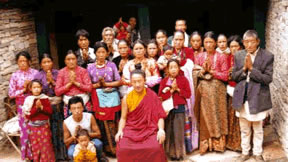 The
Drikung Gyalpo Family invited us all to be their guests
in Dung Nyil. They arranged a bed for Senge Rinpoche in their shrine
and the rest of the group camped on the roof of their house. We
left at daybreak next morning and found that many people were queuing
up to see Senge Rinpoche and to receive blessings. Our next destination
was the Techu Rong area. As we passed through, people came from
villages near and far to see Rinpoche, and some were curious about
who we were. The villagers we met on the path looked Tibetan but
were dressed in traditional Nepalese costumes. Often, to the complete
amazement of the monks, we were offered plates heaped with rice
with Nepali rupee notes sticking out of them. This was the first
time any of us had seen this kind of offering. That night we stayed
in an empty guest house situated by a large metal bridge. We borrowed
a broken bed for Rinpoche, and the rest of us slept on the ground
with our cushions and sleeping bags. We had been given vegetables
in Dung Nyil, which we cooked ourselves. Again at sunset, villagers
came with their offerings to see Rinpoche. The
Drikung Gyalpo Family invited us all to be their guests
in Dung Nyil. They arranged a bed for Senge Rinpoche in their shrine
and the rest of the group camped on the roof of their house. We
left at daybreak next morning and found that many people were queuing
up to see Senge Rinpoche and to receive blessings. Our next destination
was the Techu Rong area. As we passed through, people came from
villages near and far to see Rinpoche, and some were curious about
who we were. The villagers we met on the path looked Tibetan but
were dressed in traditional Nepalese costumes. Often, to the complete
amazement of the monks, we were offered plates heaped with rice
with Nepali rupee notes sticking out of them. This was the first
time any of us had seen this kind of offering. That night we stayed
in an empty guest house situated by a large metal bridge. We borrowed
a broken bed for Rinpoche, and the rest of us slept on the ground
with our cushions and sleeping bags. We had been given vegetables
in Dung Nyil, which we cooked ourselves. Again at sunset, villagers
came with their offerings to see Rinpoche.
 Welcoming
Procession at Terab Gonpa. As we approached Terab (also
known as Do) in the afternoon, the monks of Terab Monastery received
us with the traditional Tibetan ceremony for welcoming reincarnations
and high Lamas. The first strange thing we noticed about these monks
was that they all had long dreadlocks tied around their heads, which
is only common for monks in long-term retreats. Later, when we spent
the evening with the monks at the monastery, we found that the older
monks at the monastery were not real monks, but Ngagpas. Ngagpas
are householders who live with their families and usually only come
to the monastery to perform Pujas and ceremonies. In the Dolpo dialect,
they call all Ngagpas and monks "Lamas". However, as it
is true that the Ngagpas are the teachers of Buddhism in their region,
they are referred to as "teachers" (which is what the
word "Lama" means). Welcoming
Procession at Terab Gonpa. As we approached Terab (also
known as Do) in the afternoon, the monks of Terab Monastery received
us with the traditional Tibetan ceremony for welcoming reincarnations
and high Lamas. The first strange thing we noticed about these monks
was that they all had long dreadlocks tied around their heads, which
is only common for monks in long-term retreats. Later, when we spent
the evening with the monks at the monastery, we found that the older
monks at the monastery were not real monks, but Ngagpas. Ngagpas
are householders who live with their families and usually only come
to the monastery to perform Pujas and ceremonies. In the Dolpo dialect,
they call all Ngagpas and monks "Lamas". However, as it
is true that the Ngagpas are the teachers of Buddhism in their region,
they are referred to as "teachers" (which is what the
word "Lama" means).
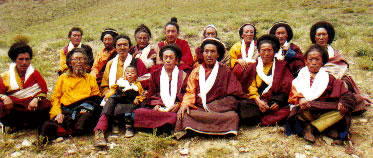
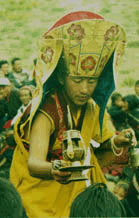 Phowa
and Long Empowerment by Senge Rinpoche.
We traveled for three long days. So, we decided to have a rest at
Terab Monastery. We spent the day bathing and cleaning our clothes,
although the villagers came continuously for an audience with Senge
Rinpoche. The Lamas at the monastery asked Senge Rinpoche to give
a public audience and teaching to the villagers. Phowa
and Long Empowerment by Senge Rinpoche.
We traveled for three long days. So, we decided to have a rest at
Terab Monastery. We spent the day bathing and cleaning our clothes,
although the villagers came continuously for an audience with Senge
Rinpoche. The Lamas at the monastery asked Senge Rinpoche to give
a public audience and teaching to the villagers.
The next day, Lama Namgyal,
the head of the Terab monastery, sent some young monks to announce
the arrival of Senge Rinpoche to the villagers. Before daybreak,
many people arrived from the surrounding villages and many came
on horseback from much further a field. More than five hundred people
gathered to receive the long-life empowerment and the Phowa transmission.
When the teachings were completed, all the people formed a queue
to see Senge Rinpoche one by one, so everybody had a chance to have
a close look at Rinpoche and to talk to him if they had anything
to tell him or ask him.
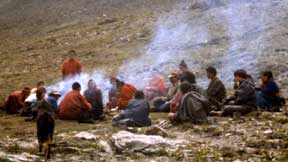 
While we were at Terab Gonpa,
we had to return the horses we had hired from Zuphel. Then, we hired
six yaks to carry our luggage and left Terab Gonpa early in the
morning for our next destination: the Khungla Mugchu Pass. Unfortunately,
heavy rain fell that afternoon so we were only able to boil a bowl
of black tea on some wet wood and had a simple dinner of tea with
Tsampa (roasted barley flour). We went to bed on an open plain listening
to the chill wind.
She-La Mugchung.
Mr Pema told us of two more mountain passes ahead of us before we
would reach Sumdo monastery, at the sacred Shel-Re Drugdra. It sounded
difficult, but we crossed La Moche Mountain before lunchtime and,
that afternoon, Senge Rinpoche and the rest of us were able to see
the sacred mountain from the top of She La Mugchung Mountain. Shel
La Mugchung is where people place prayer flags, build stone mandala
offerings and burn incense over the distance towards the Shel-Re
Drugda, so we did the same, rejoicing that we only had four more
hours to go before reaching Sumdo monastery.
At the Crystal Mountain of Dolpo

Sumdo is the
Base Camp of Shel-Re Drugdra, is a beautiful, open valley where
pilgrims and visitors set up camp and return at night after circumambulating
the sacred mountain and visiting the local holy sites and the monasteries.
Some pilgrims stay at Sumdo for many months in order to circumambulate
from three to more than one hundred times, often circling the mountain
while performing full-body prostrations. On our arrival, hundreds
of tents already covered the Sumdo valley and there were temporary
restaurants for the great festival of the Dragon Year of the sacred
Shel-Re Drugda.
Sumdo Gompa is a monastery of seven monks in total, but normally only three
are in residence. It is hard for pilgrims and visitors to tell the
monks from lay people because most of them have quite long hair
and wear Chupas (traditional Tibetan lay dress).
 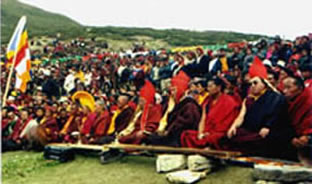
At the festival of the
Crystal Mountain, Dolpo regional people made a series of
spectacular cultural presentations and a great number of Buddhists
practioners of different traditions of Buddhism came to join the
festival.
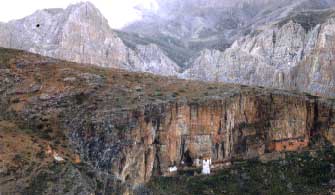
Tsakhang Monastery, we moved there after three days at Sumdo. Tsakhang Gonpa
was founded on the place where Druptop Senge Yeshi saw eighty Mahasiddhas
on the side of the rocky mountain. Beside the monastery there is
a cave that was recognized as the cave of Phagmo (Vajrayogini).
Near the monastery, there are several kinds of naturally-colored
soils which local people use to paint the monasteries. Lama Lobsang,
the monks and the Shel Tulku of Tsakhang Gonpa offered us every
hospitality, allowing us to stay in the monastery and helping to
organize the Dharma activities that Senge Rinpoche performed with
his monks every day. For six days, Senge Rinpoche gave public teachings
and Phowa transmissions to many pilgrims at Phagmo Cave.
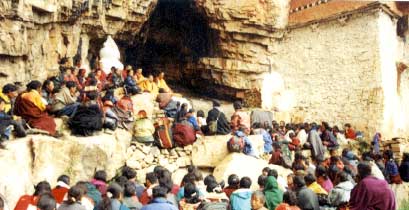
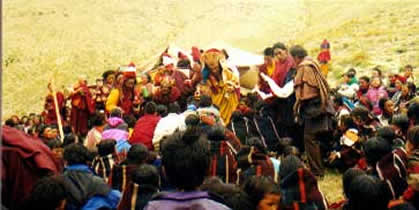
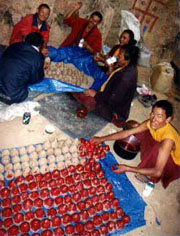 Led
by Senge Rinpoche, and his colleagues from his three years' retreat,
our group performed the three days Decheg ceremony after an all-day
preparation. The sacred Shel-Re-Drugda is known to be one of the
seats of Dechog (otherwise known as Chakrasamvara). Then, on the
fourth night, some of us stayed up the whole night to cook deep-fried
cakes (kabse) and to make other preparations for the "Tsok"
offering on the next day. On the 30th, according to the Tibetan
calendar, we made ten thousand Phagmo Tsok offerings. The idea of
a Tsok ritual is to invite enlightened beings and deities to enjoy
the Tsok offering, which is traditionally made out of Tsampa dough
and shaped like a round mountain. In India and Nepal, bread, biscuits
and other foods are also used. In the ritual, the enlightened beings
are asked to bless the Tsok which is then distributed to people
as blessed food. It is believed that performing the Tsok offering
purifies unwholesome deeds and accumulates great merit for creating
peace in the surrounding environment. When we had completed the
Tsok ritual, we took all the Tsok to nearby Gomoche Gonpa where
we gave it, together with Tibetan butter tea, to thousands of pilgrims
and visitors. Led
by Senge Rinpoche, and his colleagues from his three years' retreat,
our group performed the three days Decheg ceremony after an all-day
preparation. The sacred Shel-Re-Drugda is known to be one of the
seats of Dechog (otherwise known as Chakrasamvara). Then, on the
fourth night, some of us stayed up the whole night to cook deep-fried
cakes (kabse) and to make other preparations for the "Tsok"
offering on the next day. On the 30th, according to the Tibetan
calendar, we made ten thousand Phagmo Tsok offerings. The idea of
a Tsok ritual is to invite enlightened beings and deities to enjoy
the Tsok offering, which is traditionally made out of Tsampa dough
and shaped like a round mountain. In India and Nepal, bread, biscuits
and other foods are also used. In the ritual, the enlightened beings
are asked to bless the Tsok which is then distributed to people
as blessed food. It is believed that performing the Tsok offering
purifies unwholesome deeds and accumulates great merit for creating
peace in the surrounding environment. When we had completed the
Tsok ritual, we took all the Tsok to nearby Gomoche Gonpa where
we gave it, together with Tibetan butter tea, to thousands of pilgrims
and visitors.
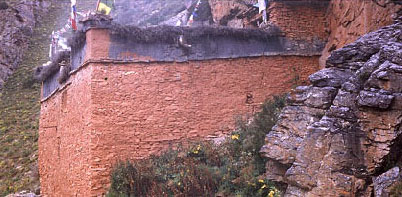
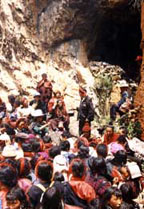 Gomoche
Monastery is also an important historical part of the sacred
site. The name of the monastery means "the Big Gate". Gomoche
Monastery is also an important historical part of the sacred
site. The name of the monastery means "the Big Gate". 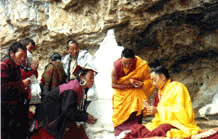 Druptop
Senge Yeshi himself stayed near the present location of the monastery
for two different retreats in a cave called Dorjee Phuk. Finally,
as the story says, in order to build a monastery, he brought a big
bowl full of barley from a secret store in Phagmo's Cave to fund
the construction. Druptop
Senge Yeshi himself stayed near the present location of the monastery
for two different retreats in a cave called Dorjee Phuk. Finally,
as the story says, in order to build a monastery, he brought a big
bowl full of barley from a secret store in Phagmo's Cave to fund
the construction.
Because of the old and dilapidated
condition of the monastery, Senge Rinpoche gave an audience outside
it to masses of pilgrims. In fact, no monks live in Gomoche at present
as it is almost ready to collapse. Senge Rinpoche and all the people
assembled who wanted to receive blessing from him had a great opportunity
to share the moment. Many went to him and spoke to him frankly of
their family situations and made requests.
On Our Way Back
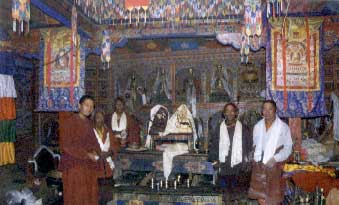
After two weeks at Tsakhang
Gonpa, we returned to Sumdo monastery. The lamas
of Sumdo strongly urged Senge Rinpoche to be their spiritual guide
and help them to restore the Gomoche Gonpa building. In response,
Senge Rinpoche gave them two sacred statuettes and a Thangka depicting
all the masters of the Drikung Kagyu lineage. It was obvious that
we had formed a strong connection with the lamas and lay people
at Sumdo, but the time had come to return to Zuphel airport.
 Jampa
Monastery sent an invitation to Senge Rinpoche and the
group on our way back to Terab village. On our arrival, the lamas
at Jampa Gonpa and a large number of local people came to receive
us. There, the devotees offered apples to Senge Rinpoche when they
came for audiences. Jampa
Monastery sent an invitation to Senge Rinpoche and the
group on our way back to Terab village. On our arrival, the lamas
at Jampa Gonpa and a large number of local people came to receive
us. There, the devotees offered apples to Senge Rinpoche when they
came for audiences.
When we passed through Terab,
we had not planned to stay at the monastery, but the lamas and the
villagers asked us to stop there for a day. During the day, when
Senge Rinpoche was busy giving audiences to the villagers, the lamas
at the Gonpa told him about the spiritual conditions in Dolpo, appealing
to Senge Rinpoche to be their spiritual guide and help them to preserve
and promote Buddhism in the region. From Terab Gonpa, we went to
Sundal, where more villagers came to see Rinpoche and again offered
us huge quantities of apples.
Drikung Monastery We arrived in the Drikung Region late in the afternoon. A long line
of villagers and the lamas at Drikung Gonpa performed the traditional
welcoming ceremony for Senge Rinpoche. At nights, we slept in our
guide, Mr Pema's, house. We stayed at Drikung Gonpa for three days.
On the first day, we performed a Tsok offering Jupa with the lamas
at Drikung Gonpa. On the next two days, Senge Rinpoche gave a long-life
empowerment and Phowa transmission to more then six hundred followers
who came from all the villages of the Drikung region.
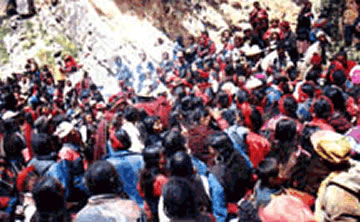 During
the teachings, Senge Rinpoche exhorted the audience to avoid the
Ten Non-Virtuous Actions, as he always does when he gives public
teachings. Many of the devotees who traditionally practice "Sang
Ridha" (animal sacrifice) as part of an old shamanic tradition,
took vows to avoid killing and other non-virtuous actions. In the
Sang Ridha festival, every family makes a big fire on their roof
and the blood from a sacrificed chicken is sprinkled on the fire.
To our eyes, it appeared that the Buddhist traditions were weakened
by the lack of teachers and the strength of local shamanic and Hindu
traditions. In the evenings, Rinpoche and his attendant monks gave
blessings to many households at Drikung where they were offered
food and drinks. A few childless couples asked Rinpoche to bless
them with a child. Indeed, the belief they had in Senge Rinpoche
because of his connection with Druptop Senge Yeshi was remarkable. During
the teachings, Senge Rinpoche exhorted the audience to avoid the
Ten Non-Virtuous Actions, as he always does when he gives public
teachings. Many of the devotees who traditionally practice "Sang
Ridha" (animal sacrifice) as part of an old shamanic tradition,
took vows to avoid killing and other non-virtuous actions. In the
Sang Ridha festival, every family makes a big fire on their roof
and the blood from a sacrificed chicken is sprinkled on the fire.
To our eyes, it appeared that the Buddhist traditions were weakened
by the lack of teachers and the strength of local shamanic and Hindu
traditions. In the evenings, Rinpoche and his attendant monks gave
blessings to many households at Drikung where they were offered
food and drinks. A few childless couples asked Rinpoche to bless
them with a child. Indeed, the belief they had in Senge Rinpoche
because of his connection with Druptop Senge Yeshi was remarkable.
Back at Dung Nyil,
our first stop when we had set out from the airport, the villagers
requested a teaching. So Senge Rinpoche gave the last Phowa transmission
of our pilgrimage and spoke about Buddhism in general to the people
of Dung Nyil city. Rinpoche also visited many households in order
to give them blessings. After missing the first flight from Zuphel,
Rinpoche and the group flew from Dung Nyil city to Kathmandu, the
capital of Nepal.
Senge Tenzin Rinpoche is considered
to be the present living reincarnation of Druptop Senge Yeshi, who
was known as the "door opener" to the sacred Dolpo Shel-Re-Drugda
and is still highly-respected and remembered in the hearts of the
people of Dolpo.
|






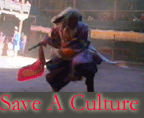

 Dolpo
Shel-Re Drugdra is the Tibetan name of the sacred mountain.
It literally means "Dolpo Crystal Mountain of the Dragon's
Roar". The Crystal Mountain is situated in Dolpo, in north-east
Nepal.
Dolpo
Shel-Re Drugdra is the Tibetan name of the sacred mountain.
It literally means "Dolpo Crystal Mountain of the Dragon's
Roar". The Crystal Mountain is situated in Dolpo, in north-east
Nepal.  Dechog
is a wrathful Tantric deity, whose image is usually depicted as
locked in sexual congress with his
consort, Dorjee Phagmo. Together, the pair symbolize the union of
the great compassion and the wisdom, which are an essential combination
for achieving enlightenment. The practices associated with Dechog
are widely practiced by all the Tantric traditions of Tibetan Buddhism.
Dechog
is a wrathful Tantric deity, whose image is usually depicted as
locked in sexual congress with his
consort, Dorjee Phagmo. Together, the pair symbolize the union of
the great compassion and the wisdom, which are an essential combination
for achieving enlightenment. The practices associated with Dechog
are widely practiced by all the Tantric traditions of Tibetan Buddhism. In
1995, Senge Tenzin Rinpoche was recognized as the reincarnation
of the great saint, Senge Yeshi (the Limi Tulku), by His Holiness
the Drikung Kyabgon Chetsang Rinpoche, the head of Drikung Kagyu
Order.
In
1995, Senge Tenzin Rinpoche was recognized as the reincarnation
of the great saint, Senge Yeshi (the Limi Tulku), by His Holiness
the Drikung Kyabgon Chetsang Rinpoche, the head of Drikung Kagyu
Order.  At
Zuphel, we met Mr Pema carrying a prayer wheel in his right
hand and a Mala, or rosary, in his left hand. He was the first local
Dolpo person we met. We introduced Senge Rinpoche and ourselves
to him. To our surprise, Pema was very humble and extremely respectful
to Senge Rinpoche and us. It showed us how to behave towards the
local people. Later, we were told that Mr Pema was well-known for
his kindheartness. He spent a great deal of his time helping pilgrims
on their way to Crystal Mountain. He was to be our guide. We learned
many things from him about the area and the people of Dolpo. We
hired four horses to carry our luggage and went to the city of Dung
Nyil, about three hours from Zuphel.
At
Zuphel, we met Mr Pema carrying a prayer wheel in his right
hand and a Mala, or rosary, in his left hand. He was the first local
Dolpo person we met. We introduced Senge Rinpoche and ourselves
to him. To our surprise, Pema was very humble and extremely respectful
to Senge Rinpoche and us. It showed us how to behave towards the
local people. Later, we were told that Mr Pema was well-known for
his kindheartness. He spent a great deal of his time helping pilgrims
on their way to Crystal Mountain. He was to be our guide. We learned
many things from him about the area and the people of Dolpo. We
hired four horses to carry our luggage and went to the city of Dung
Nyil, about three hours from Zuphel. The
Drikung Gyalpo Family invited us all to be their guests
in Dung Nyil. They arranged a bed for Senge Rinpoche in their shrine
and the rest of the group camped on the roof of their house. We
left at daybreak next morning and found that many people were queuing
up to see Senge Rinpoche and to receive blessings. Our next destination
was the Techu Rong area. As we passed through, people came from
villages near and far to see Rinpoche, and some were curious about
who we were. The villagers we met on the path looked Tibetan but
were dressed in traditional Nepalese costumes. Often, to the complete
amazement of the monks, we were offered plates heaped with rice
with Nepali rupee notes sticking out of them. This was the first
time any of us had seen this kind of offering. That night we stayed
in an empty guest house situated by a large metal bridge. We borrowed
a broken bed for Rinpoche, and the rest of us slept on the ground
with our cushions and sleeping bags. We had been given vegetables
in Dung Nyil, which we cooked ourselves. Again at sunset, villagers
came with their offerings to see Rinpoche.
The
Drikung Gyalpo Family invited us all to be their guests
in Dung Nyil. They arranged a bed for Senge Rinpoche in their shrine
and the rest of the group camped on the roof of their house. We
left at daybreak next morning and found that many people were queuing
up to see Senge Rinpoche and to receive blessings. Our next destination
was the Techu Rong area. As we passed through, people came from
villages near and far to see Rinpoche, and some were curious about
who we were. The villagers we met on the path looked Tibetan but
were dressed in traditional Nepalese costumes. Often, to the complete
amazement of the monks, we were offered plates heaped with rice
with Nepali rupee notes sticking out of them. This was the first
time any of us had seen this kind of offering. That night we stayed
in an empty guest house situated by a large metal bridge. We borrowed
a broken bed for Rinpoche, and the rest of us slept on the ground
with our cushions and sleeping bags. We had been given vegetables
in Dung Nyil, which we cooked ourselves. Again at sunset, villagers
came with their offerings to see Rinpoche.  Welcoming
Procession at Terab Gonpa. As we approached Terab (also
known as Do) in the afternoon, the monks of Terab Monastery received
us with the traditional Tibetan ceremony for welcoming reincarnations
and high Lamas. The first strange thing we noticed about these monks
was that they all had long dreadlocks tied around their heads, which
is only common for monks in long-term retreats. Later, when we spent
the evening with the monks at the monastery, we found that the older
monks at the monastery were not real monks, but Ngagpas. Ngagpas
are householders who live with their families and usually only come
to the monastery to perform Pujas and ceremonies. In the Dolpo dialect,
they call all Ngagpas and monks "Lamas". However, as it
is true that the Ngagpas are the teachers of Buddhism in their region,
they are referred to as "teachers" (which is what the
word "Lama" means).
Welcoming
Procession at Terab Gonpa. As we approached Terab (also
known as Do) in the afternoon, the monks of Terab Monastery received
us with the traditional Tibetan ceremony for welcoming reincarnations
and high Lamas. The first strange thing we noticed about these monks
was that they all had long dreadlocks tied around their heads, which
is only common for monks in long-term retreats. Later, when we spent
the evening with the monks at the monastery, we found that the older
monks at the monastery were not real monks, but Ngagpas. Ngagpas
are householders who live with their families and usually only come
to the monastery to perform Pujas and ceremonies. In the Dolpo dialect,
they call all Ngagpas and monks "Lamas". However, as it
is true that the Ngagpas are the teachers of Buddhism in their region,
they are referred to as "teachers" (which is what the
word "Lama" means).









 Led
by Senge Rinpoche, and his colleagues from his three years' retreat,
our group performed the three days Decheg ceremony after an all-day
preparation. The sacred Shel-Re-Drugda is known to be one of the
seats of Dechog (otherwise known as Chakrasamvara). Then, on the
fourth night, some of us stayed up the whole night to cook deep-fried
cakes (kabse) and to make other preparations for the "Tsok"
offering on the next day. On the 30th, according to the Tibetan
calendar, we made ten thousand Phagmo Tsok offerings. The idea of
a Tsok ritual is to invite enlightened beings and deities to enjoy
the Tsok offering, which is traditionally made out of Tsampa dough
and shaped like a round mountain. In India and Nepal, bread, biscuits
and other foods are also used. In the ritual, the enlightened beings
are asked to bless the Tsok which is then distributed to people
as blessed food. It is believed that performing the Tsok offering
purifies unwholesome deeds and accumulates great merit for creating
peace in the surrounding environment. When we had completed the
Tsok ritual, we took all the Tsok to nearby Gomoche Gonpa where
we gave it, together with Tibetan butter tea, to thousands of pilgrims
and visitors.
Led
by Senge Rinpoche, and his colleagues from his three years' retreat,
our group performed the three days Decheg ceremony after an all-day
preparation. The sacred Shel-Re-Drugda is known to be one of the
seats of Dechog (otherwise known as Chakrasamvara). Then, on the
fourth night, some of us stayed up the whole night to cook deep-fried
cakes (kabse) and to make other preparations for the "Tsok"
offering on the next day. On the 30th, according to the Tibetan
calendar, we made ten thousand Phagmo Tsok offerings. The idea of
a Tsok ritual is to invite enlightened beings and deities to enjoy
the Tsok offering, which is traditionally made out of Tsampa dough
and shaped like a round mountain. In India and Nepal, bread, biscuits
and other foods are also used. In the ritual, the enlightened beings
are asked to bless the Tsok which is then distributed to people
as blessed food. It is believed that performing the Tsok offering
purifies unwholesome deeds and accumulates great merit for creating
peace in the surrounding environment. When we had completed the
Tsok ritual, we took all the Tsok to nearby Gomoche Gonpa where
we gave it, together with Tibetan butter tea, to thousands of pilgrims
and visitors. 
 Gomoche
Monastery is also an important historical part of the sacred
site. The name of the monastery means "the Big Gate".
Gomoche
Monastery is also an important historical part of the sacred
site. The name of the monastery means "the Big Gate".  Druptop
Senge Yeshi himself stayed near the present location of the monastery
for two different retreats in a cave called Dorjee Phuk. Finally,
as the story says, in order to build a monastery, he brought a big
bowl full of barley from a secret store in Phagmo's Cave to fund
the construction.
Druptop
Senge Yeshi himself stayed near the present location of the monastery
for two different retreats in a cave called Dorjee Phuk. Finally,
as the story says, in order to build a monastery, he brought a big
bowl full of barley from a secret store in Phagmo's Cave to fund
the construction. 
 Jampa
Monastery sent an invitation to Senge Rinpoche and the
group on our way back to Terab village. On our arrival, the lamas
at Jampa Gonpa and a large number of local people came to receive
us. There, the devotees offered apples to Senge Rinpoche when they
came for audiences.
Jampa
Monastery sent an invitation to Senge Rinpoche and the
group on our way back to Terab village. On our arrival, the lamas
at Jampa Gonpa and a large number of local people came to receive
us. There, the devotees offered apples to Senge Rinpoche when they
came for audiences.  During
the teachings, Senge Rinpoche exhorted the audience to avoid the
Ten Non-Virtuous Actions, as he always does when he gives public
teachings. Many of the devotees who traditionally practice "Sang
Ridha" (animal sacrifice) as part of an old shamanic tradition,
took vows to avoid killing and other non-virtuous actions. In the
Sang Ridha festival, every family makes a big fire on their roof
and the blood from a sacrificed chicken is sprinkled on the fire.
To our eyes, it appeared that the Buddhist traditions were weakened
by the lack of teachers and the strength of local shamanic and Hindu
traditions. In the evenings, Rinpoche and his attendant monks gave
blessings to many households at Drikung where they were offered
food and drinks. A few childless couples asked Rinpoche to bless
them with a child. Indeed, the belief they had in Senge Rinpoche
because of his connection with Druptop Senge Yeshi was remarkable.
During
the teachings, Senge Rinpoche exhorted the audience to avoid the
Ten Non-Virtuous Actions, as he always does when he gives public
teachings. Many of the devotees who traditionally practice "Sang
Ridha" (animal sacrifice) as part of an old shamanic tradition,
took vows to avoid killing and other non-virtuous actions. In the
Sang Ridha festival, every family makes a big fire on their roof
and the blood from a sacrificed chicken is sprinkled on the fire.
To our eyes, it appeared that the Buddhist traditions were weakened
by the lack of teachers and the strength of local shamanic and Hindu
traditions. In the evenings, Rinpoche and his attendant monks gave
blessings to many households at Drikung where they were offered
food and drinks. A few childless couples asked Rinpoche to bless
them with a child. Indeed, the belief they had in Senge Rinpoche
because of his connection with Druptop Senge Yeshi was remarkable.